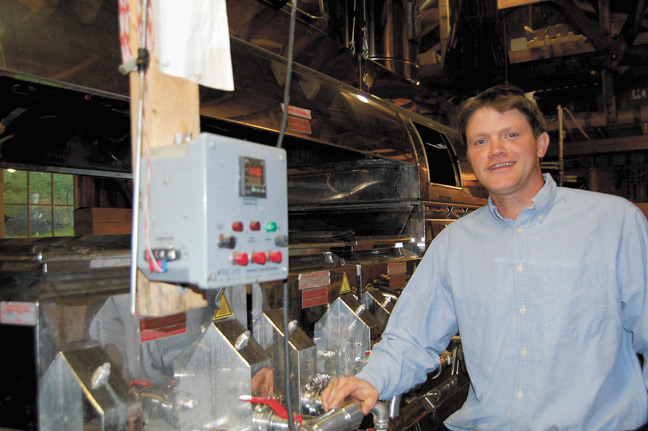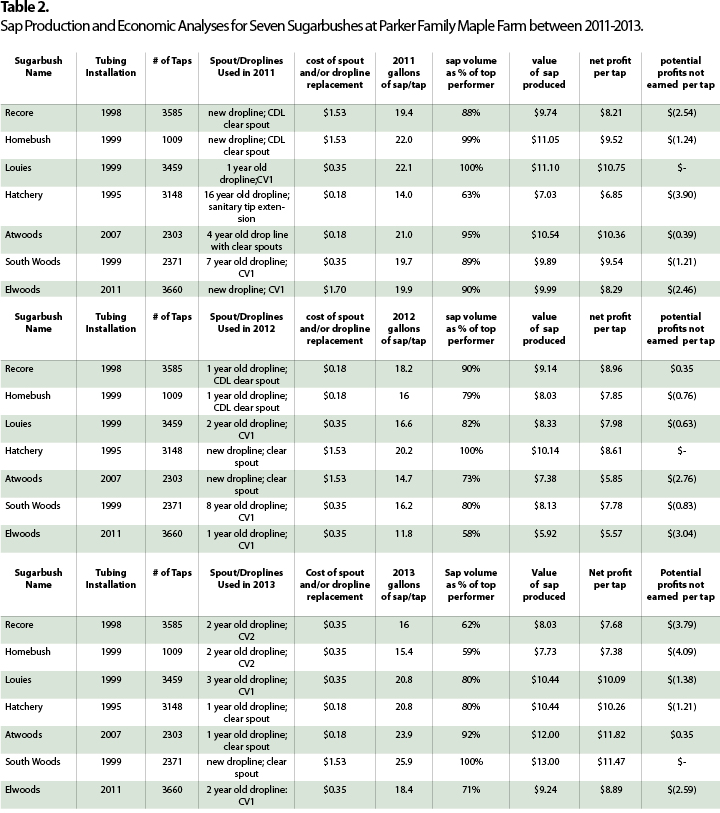Cornell Corner
Determining the value of sap you produce
Value will help you maximize profitability
By MICHAEL FARRELL |
In the previous issue of The Maple News, I submitted an article summarizing the research carried out by the Parker Family Maple Farm comparing the differences in their yields and profitability when utilizing different combinations of spouts and droplines.
Table 2 (on next page) presented a summary of the results from seven distinct sugarbushes over a 3 year time frame, but unfortunately the table was cut off in the printing process. Peter has graciously agreed to reprint Table 2 in its entirety, so if you had trouble following the analysis of the Parker research article due to the missing info on the table, refer to the original Table 2 for a more thorough explanation.
Table 2 focuses on the economic implications of replacing droplines and using different types of spouts. Note that these data were specific to the Parkers operation and those distinct sugarbushes during those years- the results could (and likely will be) different when implemented in a different sugarbush in a different year.
Also note that there are many factors that can impact sap yield, so just replacing droplines or using a certain type of spout won’t necessarily give you the same results. Furthermore, we determined that the sap that the Parkers collect is worth about $0.50 per gallon to them. This was an essential step to conduct the economic analyses. The sap you collect may be worth more or less, depending on a number of different factors.
So how do you determine the value of your own sap? If you are selling it to another producer, it is quite easy. All you need to do is take the price you are paid for the sap and subtract out the transportation costs.
However, when you are boiling the sap yourself, the math can get a little more complicated. This article addresses how you can determine the value of sap you collect and process yourself. To make it easier, I have developed an Excel-based calculator where you can input values for a number of variables and the spreadsheet determines the value of a gallon of sap.
I have included it as an additional worksheet on the ‘sap buying’ file that is available for downloading on www.cornellmaple.com The variables that go in to the analysis are presented below:
Sugar content of raw sap
The higher the sugar content of the sap, the more syrup that can be produced from that sap. Furthermore, it requires less time and fuel to process higher sugar content sap into syrup, so the fuel cost per gallon of syrup also falls as sap sugar content increases.
Total fuel/electricity cost per gallon of syrup produced
The lower the fuel cost to convert sap into syrup, the more that sap is worth. Similarly, when fuel costs are high, a gallon of sap has less value to a sugarmaker since it will require additional fuel (and therefore money) to convert the sap into syrup. Therefore, the sap collected by a large-scale sugarmaker with energy-efficient processing equipment is worth more than the sap collected by the small-scale sugarmaker who doesn’t have an RO or efficient evaporator.
Labor cost per gallon of syrup produced
If you have any hired help in your sugaring operation, it is important to factor in the wages of any employees for the time they spend handling and processing sap. Likewise, even though sugaring is a labor of love and we enjoy the time we spend sugaring, you should also consider the value of our own time. There is a real “opportunity cost” for the time you spend sugaring since theoretically you could spend your time in other gainful employment. For instance, instead of spending an extra hour sugaring, you could spend that hour working another job, so whatever rate you could make in other employment is what you should factor in for your own pay rate.
Bulk price of
maple syrup produced
Higher bulk syrup prices result in sap being worth more money to a sugarmaker. Since bulk syrup prices vary by grade and syrup produced at the end of the season is typically worth much less than table grade syrup produced in the beginning of the season, this can have a significant effect on the economics of spout and dropline replacement. If putting in new spouts and droplines allows you to produce more syrup at the end of the season, but that syrup is of low quality and value, than the additional sap produced isn’t worth as much.
Storage cost for the
additional syrup produced
If you are producing so much extra sap that you need to buy additional barrels to store the syrup, this cost should be factored in (for the first year only, assuming stainless barrels).
Variable costs for filtering sap
Every gallon of sap needs to be filtered before it enters the RO or evaporator, and often times the sap at the end of the season is difficult to filter. Thus, the additional cost of filters needs to be factored in to the actual value of raw sap, and this can have a substantial impact on late-season sap that is not easy to filter.
Variable costs for filtering syrup
The additional syrup being produced also has to be filtered, and since end of the season syrup is often difficult to filter, the additional cost must also be considered.
Depreciation on reverse osmosis
and evaporator
Processing additional sap leads to greater use of the RO and evaporator, and if the sap is of low quality at the end of the season, this can have a negative impact on the performance of these expensive items. Thus, you may wish to factor in for the extra depreciation on your equipment when processing additional sap.
Sap transportation costs
If you have to transport sap to the sugarhouse, you’ll have to figure out the cost of hauling the sap. This cost may be negligible if you are simply adding some extra gallons to an existing load of sap, but if you are producing so much additional sap that it requires an extra trip, this cost should certainly be accounted for when determining the value of sap.
How To Use These Figures
Once you have calculated the value of sap for your sugaring operation, there are several ways you can use this data.
(1) Determining if it makes sense to change droplines or purchase new spouts
Based on published research and your own experiences, you can estimate how much additional sap you may generate by replacing droplines or using a certain type of spout. By determining how much a gallon of sap is worth, you can then determine if it makes economic sense to replace your droplines or purchase a certain kind of spout.
(2) Determining if it is profitable to purchase sap
If you know the value of sap that you produce yourself, then you can use this figure to determine the maximum amount you would be able to pay for sap that someone else collects. If the price you would have to pay for the sap is less than what you value it as, then it would make sense to purchase and process additional sap.
(3) Determining if it is profitable to install a remote vacuum monitoring system
There are remote vacuum monitoring systems now on the market that allow sugarmakers to more easily monitor the vacuum levels throughout the sugarbush on a real-time basis.
Although these systems may be expensive to install, you could figure out how many extra gallons of sap you would need to produce in order to have the system pay for itself.
According to research at UVM’s Proctor Center, each additional inch of vacuum yields 5-7% of additional sap.
If the remote monitoring allows you to keep your vacuum levels higher throughout your sugarbush, you could determine how much more sap you likely produced and compare the value of the additional sap to the cost of installing the system.
February 2014
































